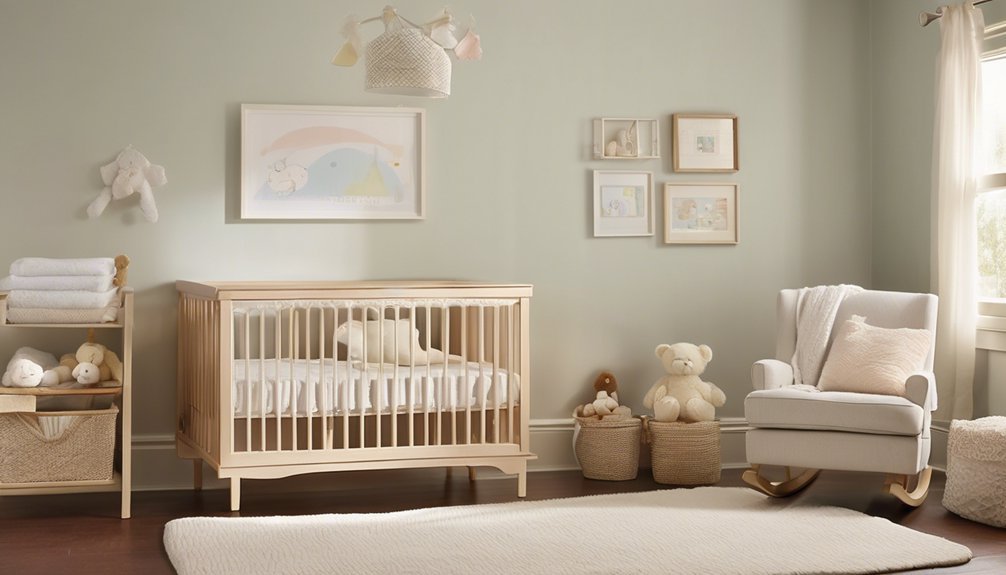Safe Sleep Practices Every Parent Should Know
As a parent, you understand the importance of keeping your infant safe during sleep. It’s essential to know that placing your baby on their back and choosing the right sleeping surface can significantly reduce the risk of Sudden Infant Death Syndrome (SIDS). You’ll also want to be mindful of the sleep environment and routines you establish. But what are the specific guidelines you should follow to ensure your baby’s safety?
Key Takeaways
- Always place infants on their backs to sleep, significantly reducing the risk of Sudden Infant Death Syndrome (SIDS).
- Use a firm mattress that fits snugly in the crib, avoiding soft bedding, pillows, or toys to prevent suffocation hazards.
- Establish a consistent sleep routine with calming bedtime rituals to help regulate your baby’s internal clock and promote better sleep quality.
- Monitor your baby’s sleep patterns and cues, and consult a pediatrician if you notice persistent sleep disturbances for tailored solutions.
- Keep the sleep environment safe and clutter-free, ensuring there are no loose blankets or toys that could pose risks during sleep.
Understanding the Importance of Safe Sleep
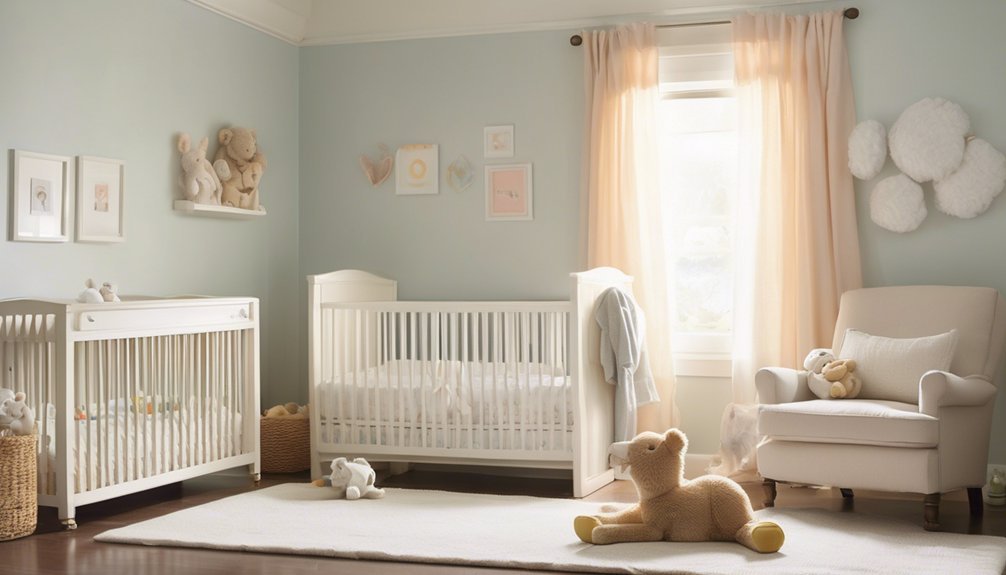
Understanding the importance of safe sleep is crucial for every parent, as it significantly reduces the risk of sudden infant death syndrome (SIDS) and other sleep-related hazards.
By prioritizing sleep safety, you create a nurturing environment where your baby can thrive. Familiarize yourself with safe sleep guidelines, like placing your infant on their back to sleep and using a firm mattress without soft bedding.
These practices enhance infant awareness during sleep, ensuring they remain in a safe position. Keep your baby’s sleep area free from toys and loose blankets to minimize risks.
Ideal Sleep Position for Infants
The ideal sleep position for infants is on their backs. This position significantly reduces the risk of sudden infant death syndrome (SIDS).
As a parent, you’ll want to pay attention to your baby’s sleep cues to ensure they’re comfortable and ready for rest. While back sleeping is crucial, tummy time is equally important when your baby is awake, helping them develop strong neck and shoulder muscles.
Here are some key points to remember:
- Always place your baby on their back for sleep.
- Use a firm mattress without soft bedding.
- Offer tummy time daily to promote development.
- Monitor your baby’s sleep cues for optimal comfort.
Choosing the Right Sleeping Surface
When selecting a sleeping surface for your infant, it’s crucial to prioritize safety and comfort. A firm mattress is essential, as it reduces the risk of suffocation and supports your baby’s developing body.
Look for a crib mattress that fits snugly in the crib, ensuring there are no gaps where your baby could become trapped. Remember, crib safety is paramount; avoid using soft bedding, pillows, or toys, as they can pose hazards.
Check for safety certifications to guarantee the mattress meets industry standards. The right sleeping surface not only promotes a safe sleep environment but also fosters healthy sleep patterns, helping your little one rest peacefully.
Trust your instincts; a safe, firm mattress is a loving choice for your baby’s sleep space.
The Role of Sleep Sacks and Swaddles
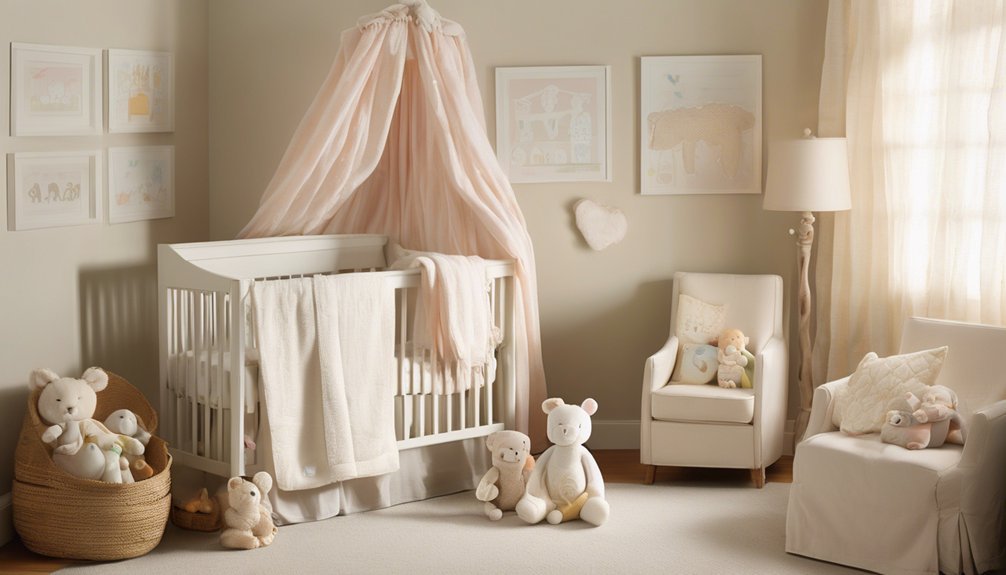
Choosing a safe sleeping surface for your infant sets the foundation for a secure sleep environment, but how your baby is wrapped can also play a significant role in their comfort and safety.
Utilizing sleep sacks and swaddles can provide numerous benefits, including:
- Enhanced Security: Swaddle techniques keep your baby snug, reducing the startle reflex that can wake them.
- Temperature Regulation: Sleep sacks help maintain an optimal body temperature, minimizing the risk of overheating.
- Prevention of Rolling: Swaddling can help prevent your infant from rolling onto their stomach too soon.
- Ease of Use: Sleep sacks simplify nighttime diaper changes without disturbing your baby’s sleep.
Maintaining a Safe Sleep Environment
Creating a safe sleep environment for your baby is essential, especially since sleep-related risks can significantly impact their well-being.
Start by following crib guidelines: ensure the crib meets current safety standards and has a firm, flat mattress. Keep the crib free from toys, pillows, and bumper pads, as these can pose suffocation hazards.
Use sleep safety tips such as placing your baby on their back to sleep and maintaining a comfortable room temperature. Avoid overheating by dressing your baby appropriately for sleep.
Regularly inspect the crib for any loose or broken parts, ensuring a secure sleep space.
Avoiding Soft Bedding and Loose Items
To ensure your baby’s sleep space remains safe, avoiding soft bedding and loose items is paramount. These elements can pose serious risks to infant safety, particularly in the form of suffocation.
Here are four essential guidelines to follow:
- Use a firm mattress: Opt for a crib mattress that meets safety standards and provides adequate support.
- Skip pillows and blankets: Keep pillows, blankets, and stuffed animals out of the crib to eliminate hazards.
- Choose fitted sheets: Invest in fitted sheets made from breathable, safe bedding materials that fit snugly over the mattress.
- Avoid crib bumpers: These can create a risk of entrapment or suffocation, so it’s best to leave them out.
The Significance of Room Sharing
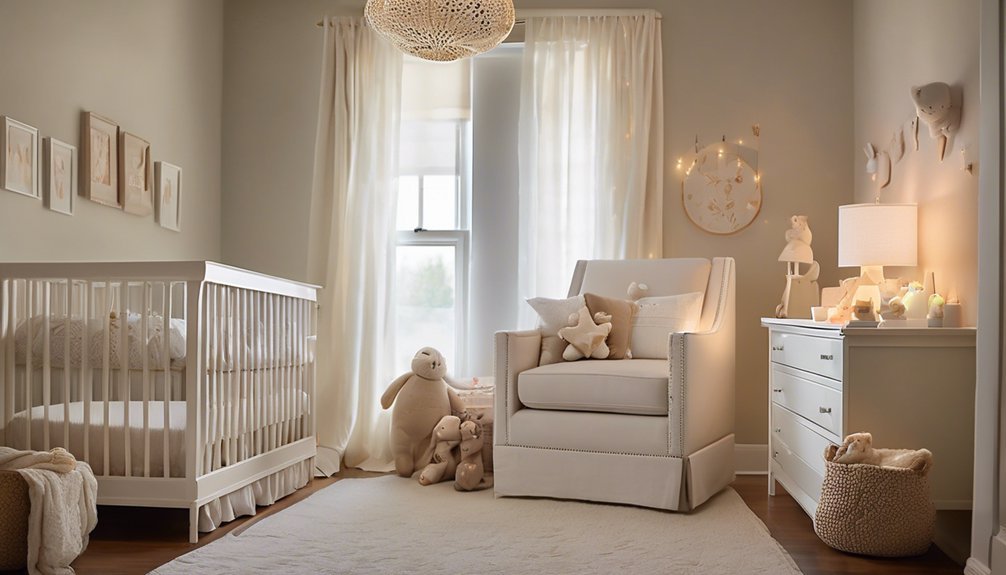
While some parents may prefer their baby to sleep in a separate room, sharing a room during the first year can significantly enhance safety and bonding.
Research shows that room sharing benefits infants by reducing the risk of Sudden Infant Death Syndrome (SIDS) and allowing for easier nighttime feedings. You can respond quickly to your baby’s needs, fostering a secure attachment.
Additionally, if you have older siblings, room sharing can promote positive sibling interactions, helping them form a close bond early on. They’ll feel involved and connected, which is essential for their emotional development.
Ultimately, sharing a room not only creates a nurturing environment for your baby but also strengthens family ties, making those precious early months even more meaningful.
Monitoring Room Temperature
As you prioritize your baby’s safety and comfort, monitoring the room temperature is crucial for promoting healthy sleep. A well-regulated environment supports your little one’s rest and reduces the risk of sleep-related issues.
Aim for a comfortable temperature between 68°F and 72°F (20°C to 22°C) and keep an eye on room humidity as well.
Here are some tips for effective temperature monitoring:
- Use a reliable thermometer to check the room’s temperature regularly.
- Invest in a hygrometer for accurate room humidity readings.
- Dress your baby in light layers to prevent overheating.
- Adjust the thermostat or use a fan to maintain optimal conditions.
Establishing a Consistent Sleep Routine
Establishing a consistent sleep routine is essential for helping your baby develop healthy sleep habits. By creating soothing bedtime rituals, you signal to your little one that it’s time to wind down.
Start with calming activities like a warm bath, gentle rocking, or reading a bedtime story. Pay close attention to your baby’s sleep cues—yawning, rubbing eyes, or fussiness are signs they’re ready for sleep.
Aim for the same bedtime each night to regulate their internal clock. Consistency not only promotes better sleep quality but also provides a sense of security for your baby.
As you nurture these habits, you’ll find that bedtime becomes a cherished time of connection and relaxation for both of you.
Being Aware of Sleep Safety Guidelines
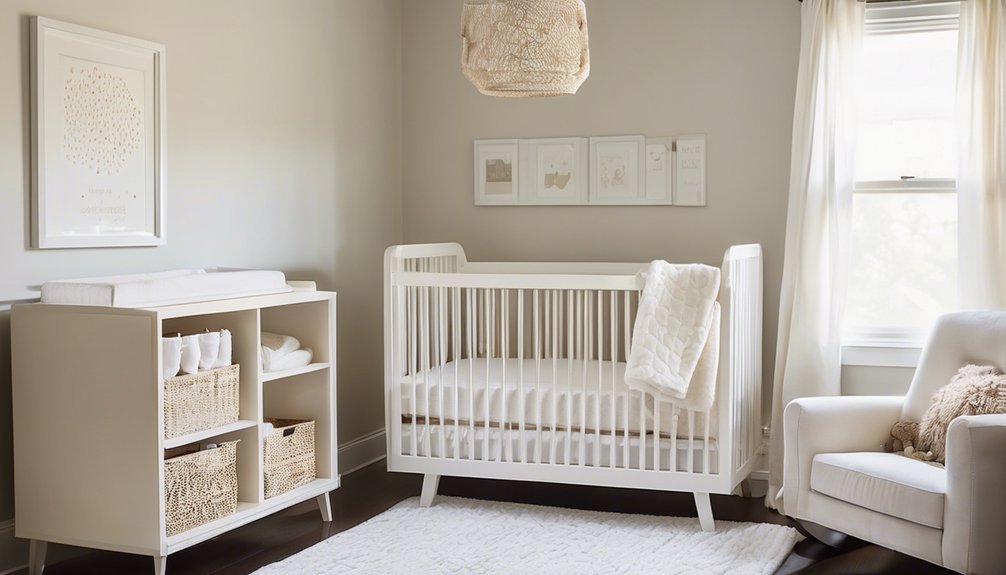
Understanding sleep safety guidelines is crucial for parents to ensure a safe sleeping environment for their baby. Many sleep safety misconceptions can put your little one at risk, so it’s essential to enhance your parental awareness.
Here are key guidelines to follow:
- Always place your baby on their back to sleep.
- Use a firm mattress with a fitted sheet, avoiding soft bedding.
- Keep the crib free from toys, pillows, and blankets to reduce suffocation risks.
- Share a room without sharing a bed; this minimizes the risk of SIDS while keeping your baby close.
Recognizing Signs of Sleep Disturbances
How can you tell if your baby is experiencing sleep disturbances? Pay close attention to their sleep patterns.
If your little one seems restless, frequently awakens during the night, or struggles to settle back down, these could be signs of sleep disturbances. You might notice increased fussiness or difficulty falling asleep, which can indicate that something is off.
Keep an eye on changes in their feeding habits or overall mood as well, as these can also correlate with sleep issues. Consistent nighttime awakenings may signal discomfort or anxiety, affecting their ability to achieve restorative sleep.
Trust your instincts—if you sense something’s not right, it’s essential to observe these signs and consider adjusting their sleep environment or routine.
Seeking Professional Guidance When Needed
If you’ve noticed persistent sleep disturbances in your baby, it might be time to seek professional guidance. Consulting experts can provide the pediatric sleep advice you need to navigate this challenging phase.
Here are a few steps to consider:
- Track Sleep Patterns: Keep a log of your baby’s sleep habits to identify triggers.
- Consult Your Pediatrician: Discuss your concerns and explore potential underlying issues.
- Visit a Sleep Specialist: If needed, a pediatric sleep consultant can offer tailored strategies.
- Join Support Groups: Connecting with other parents can provide emotional support and additional resources.
Frequently Asked Questions
When Can I Transition My Baby From a Crib to a Bed?
You can transition your baby from a crib to a bed around 2-3 years old, ensuring crib safety first. Watch for signs of readiness, like climbing, and make the bed transition smooth and comforting for them.
Are There Any Safe Sleep Practices for Premature Infants?
For your premature infant’s safety, create a calm sleep environment. Keep the crib free of soft bedding, ensure a firm mattress, and maintain a comfortable room temperature. Always place your baby on their back to sleep.
How Do I Know if My Baby Is Too Hot or Cold?
To know if your baby’s too hot or cold, monitor their temperature regularly. Dress them in appropriate sleep clothing, feeling their neck or back for signs of overheating or chill, ensuring they stay comfortable throughout the night.
What Should I Do if My Baby Rolls Over During Sleep?
If your baby rolls over during sleep, it’s normal. Ensure their sleep position is safe on their back. Keep the crib free of soft items, and monitor their comfort to maintain baby safety.
Can Sleep Training Methods Affect Safe Sleep Practices?
Think of sleep training as a dance; it can influence safe sleep practices. While techniques help establish routines, always prioritize your baby’s safety. Ensure environments remain hazard-free, regardless of the method you choose for sleep training.
Conclusion
By prioritizing safe sleep practices, you significantly reduce the risk of Sudden Infant Death Syndrome (SIDS), which affects approximately 3,400 infants each year in the U.S. Always place your baby on their back, use a firm mattress, and keep the sleeping area free of soft objects. Establishing a consistent sleep routine not only fosters healthy sleep habits but also promotes your baby’s overall development. Stay informed and vigilant, ensuring your little one has a safe and restful sleep environment.

